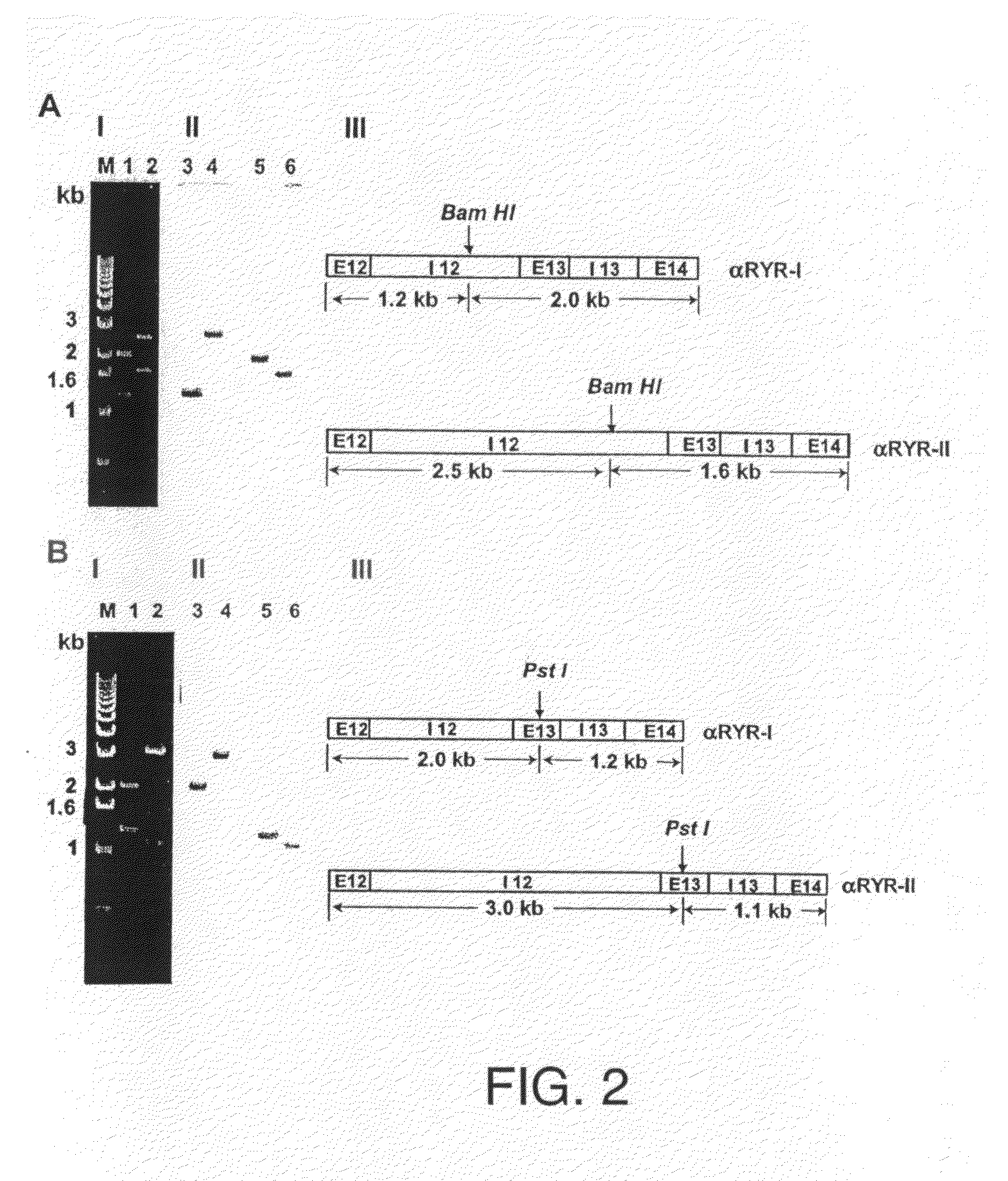Genetic test for PSE-susceptible turkeys
a gene test and pse-susceptible technology, applied in the field of turkey meat and population improvement methods and compounds, can solve the problems of poor water holding capacity, abnormal light color of pse meat, and flaccid consistency
- Summary
- Abstract
- Description
- Claims
- Application Information
AI Technical Summary
Benefits of technology
Problems solved by technology
Method used
Image
Examples
example 1
[0302]Identification of aRYR Transcript Variants in Turkey. To test the hypothesis that mutations in turkey αRYR predispose turkeys to development of PSE meat, we began screening the region corresponding to the 3′ end of mutation hot spot 1 of human RYRI. We identified three transcript variants spanning nucleotides number 1231-1947, corresponding to the human RYR1 cDNA sequence (accession no. Jo5200). The longest transcript (W) shared 70% and 60% amino acid sequence identity with mammalian RYR1 and bullfrog αRYR (Oyamada, et al., 1994), respectively (FIG. 1). Compared to turkey βRYR (our unpublished data) and chicken βRYR (Ottini, et al., 1996), the amino acid sequence identity was 66% and 58%, respectively. The other two transcript variants were characterized by the deletion of either 81-bp (variant AS-81; nucleotides number 1350-1430) or 193-bp (variant AS-193; nucleotides number 1350-1542) from the W transcript. The 81-bp deletion is predicted to result in a 27-amino acid deletio...
example 2
[0303]Two aRYR Genomic DNA Alleles. We next addressed the question of whether the deletions in the aRYR cDNA sequence originate in the genome or were the result of alternative splicing. Upon analysis of the genomic DNA sequence in the region corresponding to W, AS-81 and AS-193, we identified two copies of αRYR from different birds using genomic DNA as template. These alleles differed in size by approximately 1 kb. We refer to these two copies of turkey αRYR genomic DNA as alleles αRYR-I and αRYR-II. Due to the size of the inserts and the abundance of tandem repeated sequences in the introns which made it difficult to design sequencing primers, each allele was digested to smaller fragments with restriction enzymes, subcloned and sequenced. This strategy allowed us to sequence approximately 90% of αRYR-I and 75% of αRYR-II including their complete exon sequences. The turkey αRYR genomic DNA sequence is still unknown; therefore, each intron and exon and exon / intron boundaries of both ...
example 3
[0306]Expression of αRYR Transcript Variants. cDNA from turkeys (N=76) was screened by RT-PCR to study the expression patterns of the transcript variants. Most birds expressed all three transcript variants but there were birds that expressed W only, W with AS-193 but no AS-81 or AS-81 and AS-193 but no W (FIG. 3). These data were reproducible upon three screening experiments. We have not yet observed any birds expressing only AS-81 or AS-193 or W with AS-81. If birds expressed only AS-193, they probably could not survive because they would not have a functional α channel protein. The presence of a functional β channel does not rescue this deficiency (Airey, et al., 1993). Sequence analysis of both turkey αRYR alleles showed no evidence that the missing nucleotides in the cDNA sequence result from deletion of the analogous residues in the genomic DNA. Therefore, we concluded that the different transcript variants result form alternative splicing. Consistent with this conclusion was t...
PUM
| Property | Measurement | Unit |
|---|---|---|
| molecular mass | aaaaa | aaaaa |
| temperatures | aaaaa | aaaaa |
| diameter | aaaaa | aaaaa |
Abstract
Description
Claims
Application Information
 Login to View More
Login to View More - R&D
- Intellectual Property
- Life Sciences
- Materials
- Tech Scout
- Unparalleled Data Quality
- Higher Quality Content
- 60% Fewer Hallucinations
Browse by: Latest US Patents, China's latest patents, Technical Efficacy Thesaurus, Application Domain, Technology Topic, Popular Technical Reports.
© 2025 PatSnap. All rights reserved.Legal|Privacy policy|Modern Slavery Act Transparency Statement|Sitemap|About US| Contact US: help@patsnap.com



